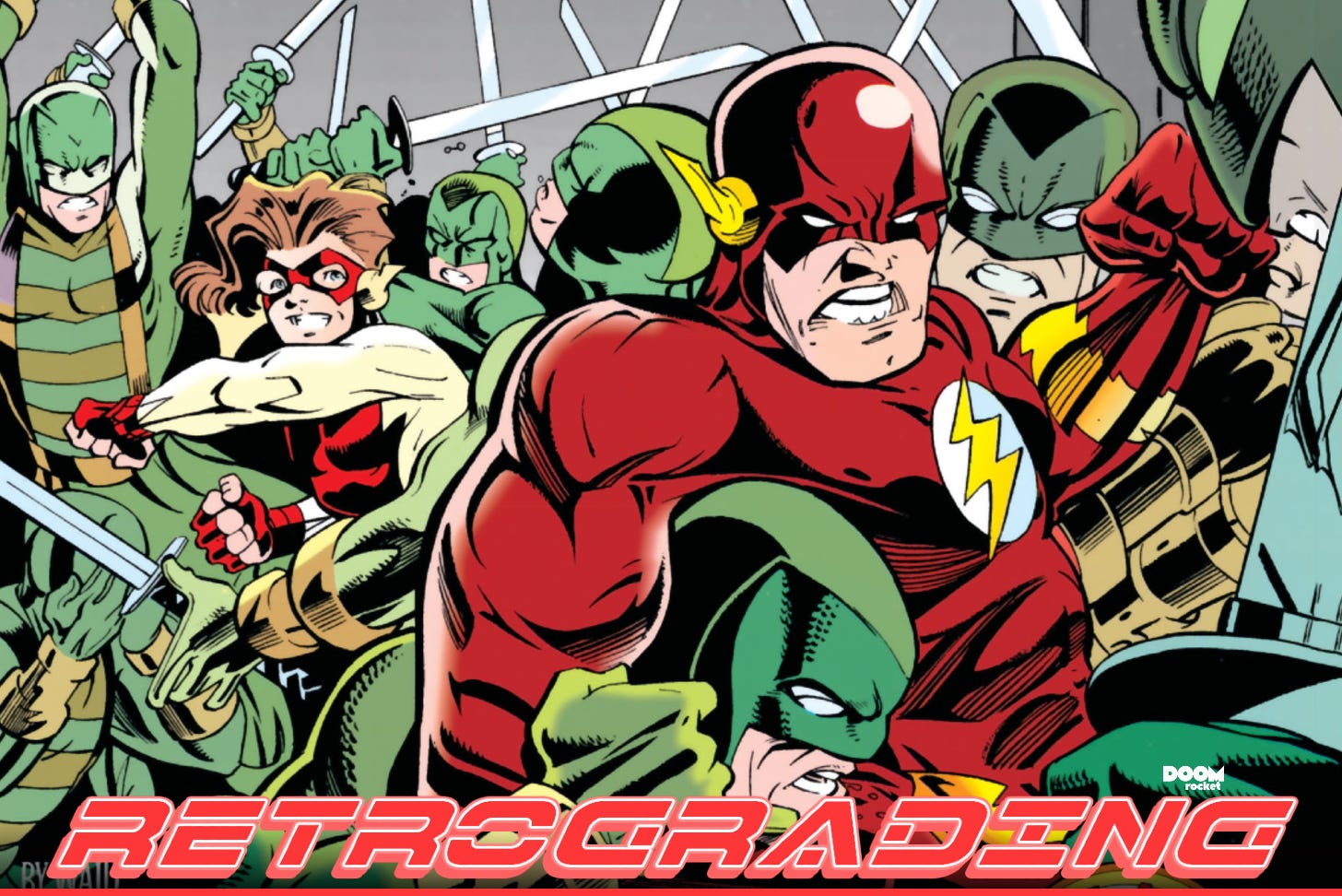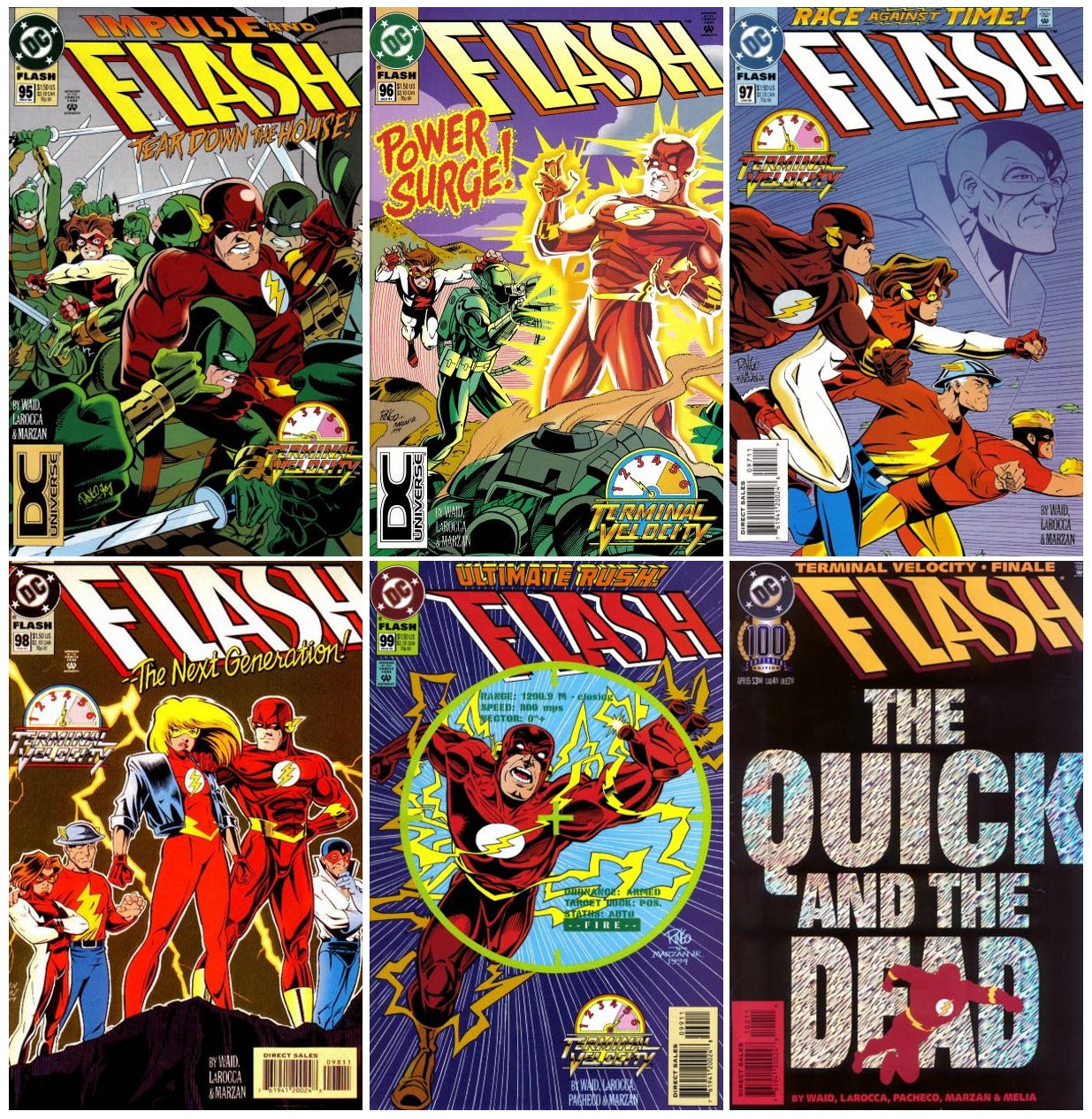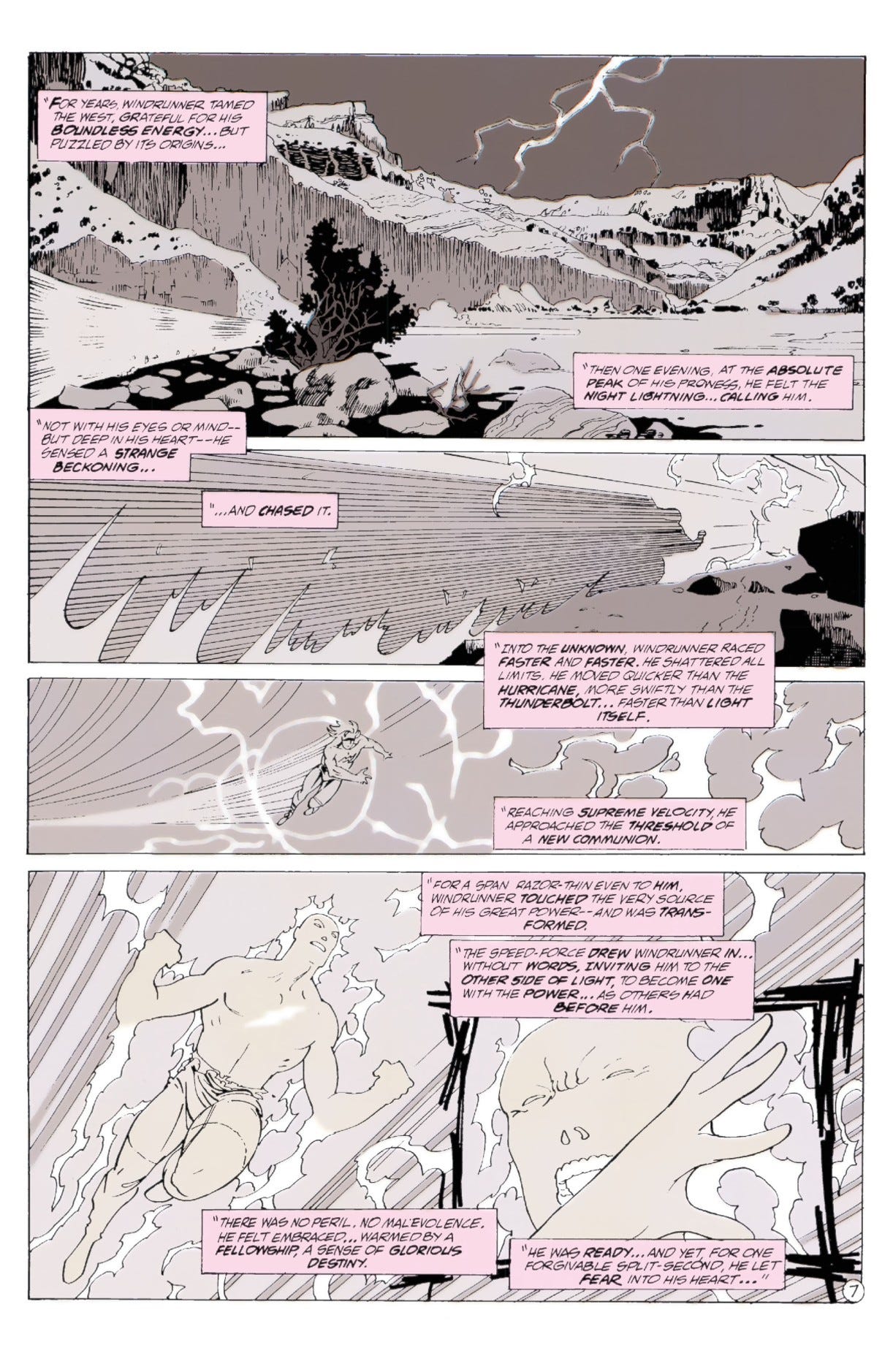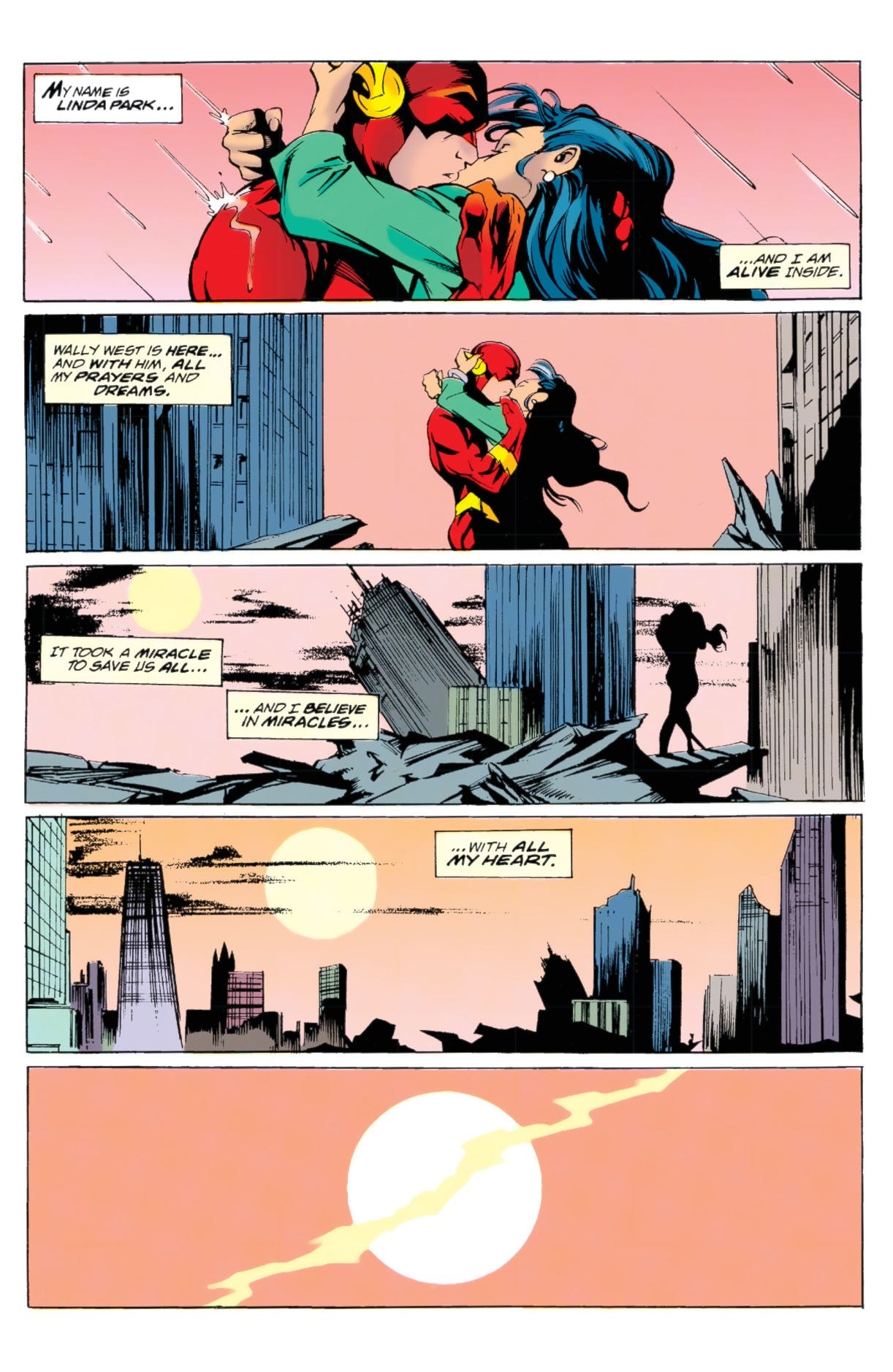"Terminal Velocity" is a fleet-footed epic for the ages
In 1994, Waid & Larroca put Wally West to the test.
This is RETROGRADING, where I feel myself transforming with every stride.
THE COMIC: Flash Vol. 2, #95-100: "Terminal Velocity"
THE YEAR: 1994. The brief 1990 Flash TV show was receding in the rearview mirror, while the comic book that inspired it was racing ahead faster than ever, a beacon of classic superhero fun on a spinner rack besieged by angst-ridden steroidal gun nuts.
THE SPECS: Written by Mark Waid; pencils by Salvador Larroca and Carlos Pacheco; inks by José Marzan Jr.; colors by Gina Going and Tom McCraw; letters by Kevin Cunningham. Covers by Mike Weiringo. Published by DC Comics.
THE MAKE: Mark Waid is back on top. Since returning to DC Comics three years ago to pen Batman/Superman: World's Finest, Waid has reasserted himself as one of the publisher's key creative forces, leading multiple crossover events and taking charge of the new flagship book Justice League Unlimited. A prominent superhero writer of the Nineties and early Aughts, he's still best known for scripting Kingdom Come, the epic Elseworlds tale painted by living legend Alex Ross. But his bread and butter has always been extended soap-operatic runs on titles like Legion of Super-Heroes, Fantastic Four, and Daredevil.
Back in the mid-'80s, Waid broke onto the comics scene as an editor and writer for fan magazine Amazing Heroes, around the time when Crisis on Infinite Earths hit the stands, during which the Silver Age Flash, Barry Allen, sacrificed his life to save the universe. Fast forward to the Nineties, and Waid, after a stint as a DC editor, was writing Flash full-time. In the intervening years, former Kid Flash Wally West had taken up Barry's mantle, but he still couldn't escape his mentor's shadow. Feelings of inadequacy plagued Wally, and suddenly, he couldn't match his predecessor's lightspeed pace; he could barely break the sound barrier. Out in the real world, comic sales were dropping.
Waid solved both problems quickly. In his second major story, "The Return of Barry Allen," Wally's predecessor appeared to have come back from the dead, only to be unmasked as Eobard Thawne, the Reverse-Flash. Wally overcame his fear of replacing his hero and broke through the mental wall holding his powers back. Thawne was left eating dust, and higher sales followed in the story's wake. Waid has been open about how, as a fanboy turned pro, he relates to Wally's transition from sidekick to Justice Leaguer. But his superpower lay in crafting straightforward, emotionally resonant adventure stories that put character first — tales that updated the optimistic, lighthearted tone of the Silver Age for a new era. In the midst of the "grim 'n' gritty" era, these were comics that leaned into the superhero basics without feeling stuck in the past. Wally wasn't a bowtie-wearing square like Barry had been, but he sure wasn't a brooding antihero either — just a guy with a cool superpower who wanted to do the right thing.
That wasn't all Waid brought to the table. He expanded Wally's supporting cast to include other speedsters, old and new. Most importantly, he introduced the Speed Force, the extra-dimensional energy source from which they all draw their power. Today, the Speed Force is the most significant part of the Flash mythology, but as Waid approached Wally's 100th issue, it was but a potential wellspring of untapped story potential. With a newcomer artist Salvador Larroca onboard and Wally's 30th-century VR-addled cousin Bart Allen (a.k.a Impulse) established, a groundbreaking story was off to the races.
THE REVIEW: "Terminal Velocity" hits the ground running when Flash arrives home from a time-travel trip burdened by a dark premonition of his future. Whatever disaster is approaching involves his girlfriend, reporter Linda Park, and Kobra, the super-terrorist whose organization has infiltrated Keystone City — and Wally isn't sharing what he knows with anyone. In his usual hot-headed manner, he believes he can fix things on his own, desperately racing against the future. At the same time, he's preparing for the worst by training Impulse to take over as the next Flash. But Wally's a lousy teacher, especially with a student whose attention span is even shorter than his.
It's a compelling premise. Heroic hubris and prophecies of doom are the essence of Greek tragedy; in classic fashion, we learn that Flash's power can make things worse. If he accelerates to lightspeed, he risks becoming pure energy, one with the Speed Force. Transcendence and enlightenment are within his reach, but Wally isn't ready to outrun his worldly attachments: the city he protects and the woman he loves. Just the kind of insightful pop philosophy superhero books excel at — The Dharma Bums for the metahuman set. Max Mercury, Zen Master of Speed, offers wisdom and insight into sci-fi spirituality, while Wally acts as the skeptical but captivated audience surrogate. (The wise, riddle-spouting elder is a time-worn archetype for a reason: it works.) A flashback to Max's secret origin in the Wild West provides an especially entertaining interlude, paralleling Wally's search for answers and linking the Flash legacy to the deeper history of pulp adventurers.
That sequence also features some pretty landscapes. Larroca's action scenes are fun and easy to follow but sometimes fall into the excesses of the era, leaning on exaggerated musculature and grimaces. Although he's moved toward stiff, digital tracery in recent years, here he excels in the quieter moments, capturing natural body language and expressions, including some hilarious reaction shots from Wally, all of which serve to emphasize Waid's strengths. On the other hand, while Waid is a natural storyteller, he struggles with his villain. Kobra has no real motivation and lacks characteristics that make him a significant threat to Flash in particular, rather than any other hero. It's frustrating. With a hitter like Gorilla Grodd at bat, Waid could've knocked this story out of the park with his eyes closed.
Regardless, Waid rounds the bases at hyperspeed and takes the win. He is especially skilled at cutting between scenes to ratchet up the tension and threading multiple subplots to keep the pace from lagging. Every issue of this run has a balanced mix of plot, character, and action; readers got a bang for their $1.50. Even when an ongoing mystery involving C-list villain Chillblaine briefly takes the stage, it doesn't feel like a distraction but rather a natural part of Wally's extraordinary life. Similarly, when Flash and Impulse talk, they're not laid out in a series of static conversations; we see them joking around while running across power lines. And Waid finds fresh, inventive uses for super-speed, like Flash leveraging wavelength refraction to see Kobra's secret energy field with his naked eye.
That attention to detail makes Waid's DCU feel like a real place you could visit, where demigods in spandex seem like old friends. His enthusiasm for playing in this universe is contagious, and even if the plot sometimes doesn't make literal sense — Kobra's master plan definitely doesn't — it always makes emotional sense. Waid has a knack for finding the heart of any story, whether it's a jewelry store heist or the apocalypse, and he's not afraid to explore big themes like love, sacrifice, and destiny. "Terminal Velocity" is a lively story about how far a good man will go to set things right. At its best, it hits like a bolt of lightning.
NOSTALGIA-FEST OR REPRESSED NIGHTMARE? Run as fast as you can — no! FASTER! — to your local comic shop and dig up these back issues. "Terminal Velocity" is stirring superhero action like they used to make 'em — that's a Flash Fact.
RETROGRADE: B+







